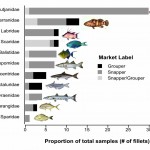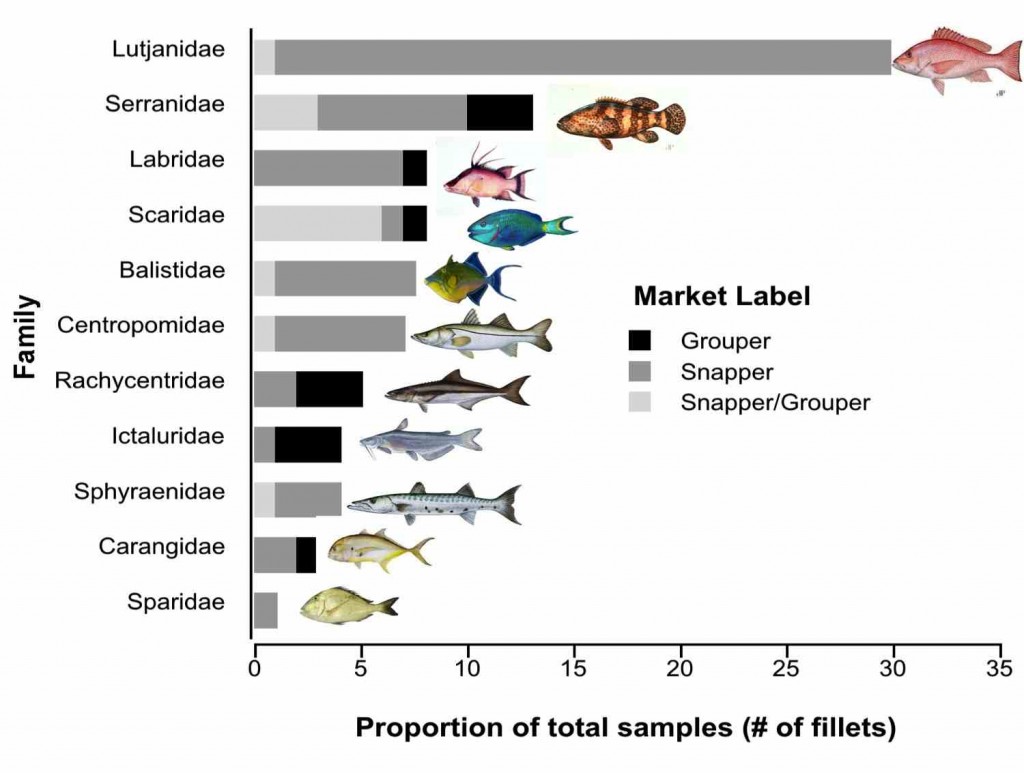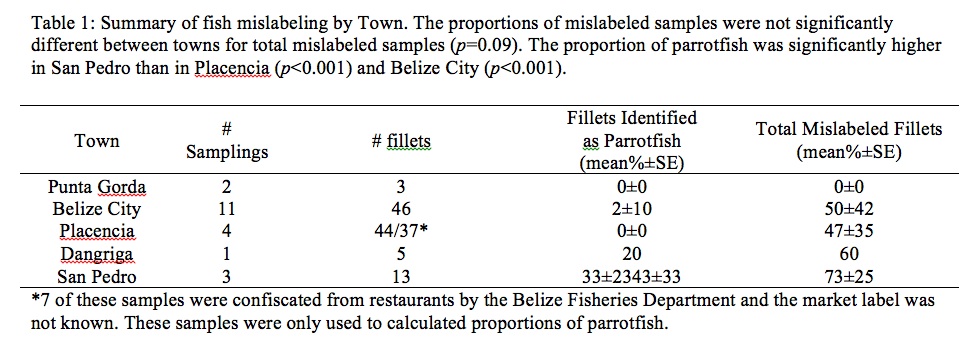This post was co-authored with Courtney Cox, a PhD student in my lab at UNC, studying fisheries management and reef resilience in Belize.
Our paper on seafood mislabeling in Belize is out in Conservation Letters (here). This paper is the fist of several from our project designed to evaluate the effectiveness of Belize’s national ban on herbivorous fish harvesting as a coral reef conservation tool. Recognizing that MPAs alone were not preventing the degradation of its invaluable reef ecosystem, the Belizean government passed a new regulation in April 2009 preventing the harvesting of any species of parrotfish (Scarids) or surgeonfish (Acanthurids) nationwide: “No person shall take in the waters of Belize, or buy, sell or have in possession any grazers” (Statutory Instrument No. 49 of 2009). This is the first legislation of its kind and, if effective, has the potential to globally revolutionize coral reef management.
Nearly all Belizeans claim they dislike and have never eaten a parrotfish, which given the severely overfished state of parrotfish populations, seems unlikely. The national grazer harvest ban also stipulates that fish fillet must be sold with a small intact skin patch, so that consumers can recognize the scales and coloration as parrotfish. However, we only observed this at one vendor in 2011 over the course of three years of sampling. As a result, visual censuses will likely miss the presence of illegally harvested herbivorous fish. After a series of interviews, meetings, and workshops with local fisherman, MPA managers, marine reserve police, biologists from the Belize Fisheries Department, and our partners within several NGOS, we have come to the conclusion that the only way to accurately assess the degree of compliance with the ban, was to purchase fillet in the markets, restaurants, grocery stores and fishing cooperatives (mainly for export) and determine the actual identity using molecular genetics.
Genetic Testing Reveals some Mislabeling but General Compliance with a Ban on Herbivorous Fish Harvesting
Abstract: Overfishing of herbivorous fishes is one of the primary causes of Caribbean coral reef decline. In Belize, herbivorous fishes comprised 28% of the catch from 2005 to 2008. In 2009, the Belize Fisheries Department implemented a national ban on herbivorous fish harvesting to mitigate high macroalgal cover on much of the Belize Barrier Reef. However, compliance with this approach has not been evaluated. We assessed the proportion of herbivorous fish in local markets by genetically identifying fish fillets sold in five major towns in Belize from 2009 to 2011. We found that 5% to 7% of 111 fillets were identified as herbivorous fish and 32% to 51% were mislabeled. A 5% to 7% proportion of parrotfish in local markets suggests some ongoing parrotfish harvesting. However, our results suggest that the ban has reduced herbivorous fish harvesting and has the potential to help facilitate the restoration of coral reef ecosystems.
We designed the sampling to maximize spatial coverage within Belize and the type of vendors sampled, and to replicate the sample collection over time. We purchased 111 fish fillets from open fish markets, supermarkets, restaurants, and/or fishing co-operatives in five major fishing and/or tourist towns along the Belize coast in May/June and October/November from 2009 to 2011. We removed approximately 1 gram of muscle tissue from the fillets and stored in 95% ethanol (the remainder of the fillet was then donated to homeless shelters). The number of fish fillets purchased varied between towns and sampling periods due to availability from fishermen and number of fish vendors.
Our results indicate that, across Belize, roughly 7% of fillets (most of which are sold are grouper, snapper or “grouper/snapper”) were parrotfish, which is signifcantly lower than the proportion of parrotfish (28%) harvested from 2005 to 2008 at Glover’s Reef Marine Reserve (Wildlife Conservation Society 2010). We also found that roughly half (51%) the fillets tested were mislabeled. Fillets purchased were labeled as snapper, grouper, snapper/grouper, cobia, tuna or snook. Only fillets labeled as snapper or grouper were mislabeled:
Figure 1. Species composition of samples labeled as snapper, grouper, and snapper/grouper.
We genetically identified fillets mislabeled as snapper or grouper to one of 11 families (Fig. 1). The proportion of mislabeled fillets that were identified as parrotfish in San Pedro (43%) was significantly higher than Placencia (0%) and Belize City (2%) (Table 1), while the proportion of overall mislabeling did not vary significantly among towns (Table 1). The proportion of parrotfish sold was significantly higher in supermarkets than in restaurants or co-operatives and the proportion of mislabeling was significantly higher in open fish markets than in restaurants.
The main incentives for fish mislabeling are meeting consumer demand and increasing profits. The supply chain in Belize is fairly short. Belizean fishermen sell their catch directly to locals in fish markets, to co-operatives who then export catch or sell to local businesses, or directly to restaurants and hotels. It is unclear where along the supply chain most mislabeling is occurring and it is possible that vendors are unknowingly mislabeling fillets, but marketing and selling an undesirable fish as a popular and expensive fish can be highly profitable. For example, in Belize, snapper can be sold for twice the price of non-target species (Wendy’s Restaurant, local restaurant – not the American chain, pers. comm. 2011). We found that snapper, grouper, and hogfish fillets were sold at an average of US$5.55 per pound, while cobia and snook fillets were sold at an average of US$2.60 per pound.



Leave a Reply